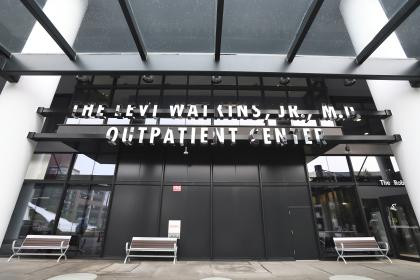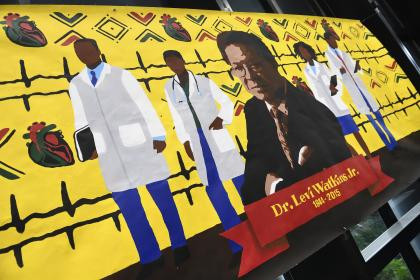Johns Hopkins University and Medicine have officially renamed the Johns Hopkins Outpatient Center in honor of Dr. Levi Watkins Jr., a pioneering figure in cardiac surgery and a champion for diversity in medicine. This rededication pays tribute to Dr. Watkins’ remarkable contributions as Johns Hopkins Medicine’s first Black chief resident and full professor, solidifying his legacy within the institution and the broader medical community.
On the evening of Thursday, June 8th, a celebratory gathering of over 150 individuals marked the unveiling of the Levi Watkins Jr., M.D., Outpatient Center. Beyond his groundbreaking achievements in cardiac surgery, Dr. Watkins is celebrated for his unwavering commitment to mentorship and his pioneering efforts to recruit underrepresented minorities into the field of medicine.
This significant renaming is a direct result of the Diverse Names and Narratives Project at Johns Hopkins. This ongoing initiative is dedicated to recognizing and celebrating individuals from the institution’s history who have made exceptional contributions, particularly those from historically marginalized and underrepresented groups. The project aims to ensure that the legacies of these remarkable figures are more prominently acknowledged and honored within the Johns Hopkins community.
 Exterior view of the Levi Watkins Jr., M.D., Outpatient Center sign, formerly Johns Hopkins Outpatient Center, showcasing the new name during the dedication ceremony
Exterior view of the Levi Watkins Jr., M.D., Outpatient Center sign, formerly Johns Hopkins Outpatient Center, showcasing the new name during the dedication ceremony
Image credit: Will Kirk / Johns Hopkins University
Dr. Levi Watkins Jr.’s journey with Johns Hopkins Medicine began in 1970 when he joined as a surgical intern. Following a research fellowship at Harvard Medical School, he made history as Johns Hopkins Hospital’s first Black chief resident in cardiac surgery. His pioneering spirit reached a pinnacle in 1980 when he performed the world’s first implantation of an automatic implantable cardioverter-defibrillator (ICD) in a human patient. This revolutionary surgical procedure has since saved countless lives by providing a critical intervention for individuals experiencing life-threatening heart rhythm disturbances.
Beyond his surgical innovations, Dr. Watkins served as an associate dean at the School of Medicine and became a deeply valued mentor. He established the nation’s first postdoctoral association, tirelessly advocated for equity and inclusion, and spearheaded initiatives to attract minority applicants to Johns Hopkins. In 1982, he launched the annual Martin Luther King Jr. Commemoration, a significant event that continues to host distinguished speakers and recognize Johns Hopkins employees for their dedication to community service. Dr. Watkins’ commitment to making Johns Hopkins more inclusive, innovative, welcoming, and connected to the Baltimore community makes him an exemplary namesake for the outpatient center, an entity dedicated to serving the local population. He passed away in April 2015 at the age of 70, leaving behind an enduring legacy.
Video credit: Johns Hopkins video team
During the dedication ceremony, JHU President Ron Daniels highlighted Dr. Watkins’ profound impact on Johns Hopkins. He emphasized Dr. Watkins’ dedication to fostering an environment where Black students, faculty, and residents could thrive, ultimately enriching the institution for everyone, including patients seeking care at the Johns Hopkins Outpatient Center.
“He sought from the core of his being to make Hopkins a place where those who followed in his footsteps would have role models, not just in their mind or in their heart, but in the labs, the offices and hallways of this hospital and of this university,” President Daniels stated. “Through all these efforts, year after year, Levi succeeded in changing the demography and the tenor of this place, making Hopkins more welcoming for all who came here, whether for work or for care. Naturally, Levi himself became a role model for generations of Hopkins students, and he made it possible, in turn, for these students to be role models for others as well.”
 Attendees gather at the Levi Watkins, Jr., M.D. Outpatient Center dedication event to celebrate the renaming and honor Dr. Watkins' legacy
Attendees gather at the Levi Watkins, Jr., M.D. Outpatient Center dedication event to celebrate the renaming and honor Dr. Watkins' legacy
Image credit: Will Kirk / Johns Hopkins University
Among the attendees at the dedication were Dr. Watkins’ sister, Annie Marie Garraway, his nephew, Levi A. Garraway, and numerous colleagues and friends. Maria Heyssel, wife of former Johns Hopkins Hospital president Robert Heyssel, was also present. Notably, the building now housing the Levi Watkins Jr., M.D., Outpatient Center was originally named after Robert Heyssel in 1992, recognizing his pivotal role in shaping Johns Hopkins into a comprehensive healthcare system.
Dr. Damani Piggott, associate vice provost for graduate diversity and partnerships and associate professor of medicine, shared a personal anecdote illustrating Dr. Watkins’ commitment to mentorship. He recalled receiving a letter from Dr. Watkins as an undergraduate at Morehouse College, a testament to Dr. Watkins’ proactive outreach to potential medical students.
“It was an amazing personal touch and a full warm embrace to inspire, to nurture, and to support all pathways to medicine,” Dr. Piggott explained. “When we ultimately landed Hopkins as trainees, Dr. Watkins would be one of the first persons to welcome us and ensure that we all persistently and consistently knew that we had a genuine place here at Hopkins and in Baltimore at large.”
 A vibrant yellow mural of Dr. Levi Watkins Jr. displayed at the Levi Watkins Jr., M.D. Outpatient Center, honoring his contributions to medicine and Johns Hopkins
A vibrant yellow mural of Dr. Levi Watkins Jr. displayed at the Levi Watkins Jr., M.D. Outpatient Center, honoring his contributions to medicine and Johns Hopkins
Image credit: Will Kirk / Johns Hopkins University
The renaming of the Johns Hopkins Outpatient Center to the Levi Watkins Jr., M.D., Outpatient Center serves as a lasting tribute to a remarkable individual whose contributions extended far beyond the operating room. Dr. Watkins’ legacy as a surgical innovator, a dedicated mentor, and a champion for diversity will continue to inspire future generations of medical professionals and reinforce Johns Hopkins’ commitment to excellence and inclusion within the Baltimore community and beyond.
